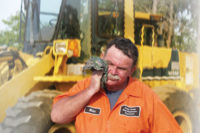Danger! Impaired workers!
Almost 13 million employees use drugs on the job

Negative effects at work
Many aspects of the workplace require alertness, as well as accurate and quick reflexes. Any kind of impairment can cause serious accidents and interfere with the accuracy and efficiency of work. Impairments can cause problems not only for the user, but for co-workers and the entire company.
Problems can include:
- After-effects of substance use, such as hangover or withdrawal, affecting job performance
- Absenteeism, illness and/or reduced productivity
- Preoccupation with obtaining and using substances while at work, interfering with attention and concentration
- Illegal activities at work, such as selling illicit drugs to other employees
- Psychological or stress-related effects due to substance abuse by a family member, friend or co-worker that affects another person’s job performance
Adding up the costs
In total, substance abuse drains more than $100 billion from American businesses every year. Here is where the money is going:
- Workers’ compensation: 38 to 50 percent of all workers’ compensation claims are related to substance abuse in the workplace; substance abusers file three to five times as many workers’ compensation claims
- Medical costs: Substance abusers incur 300 percent higher medical costs than non-abusers
- Absenteeism: Substance abusers are 2.5 times more likely to be absent eight days or more a year
- Lost productivity: Substance abusers are 1/3 less productive
- Employee turnover: It costs a business an average of $7,000 to replace a salaried worker
* Source: ‘Working Partners’, National Conference Proceedings Report: sponsored by U.S. Dept. of Labor, the SBA, and the Office of National Drug Control Policy.
In addition, one survey found that nine percent of heavy drinkers and 10 percent of drug users had missed work because of a hangover, six percent had gone to work high or drunk in the past year, and 11 percent of heavy drinkers and 18 percent of drug users had skipped work in the past month.
What can a workplace do?
Workplaces are encouraged to establish a Drug Free Workplace Program to provide help in a professional and consistent manner for employees suspected of or confirmed to be abusing substances. For these programs to succeed, companies must teach managers and supervisors to recognize and deal with substance abuse issues and offer employees more direct assistance through educational programs or referrals to community services.
Pre-planning for a Drug Free Workplace Program is the best way to avoid confusion and frustration. Case studies show that a well-planned program to reduce substance abuse can increase productivity, reduce accidents and avoid increased costs due to substance abuse-related insurance claims. Employers and employees can collaborate on the program’s design and implementation standards beforehand to outline what is an acceptable code of behavior and what is not. This way, all employees will understand what is expected of them and know that everyone will be treated the same way. Drug policies may contain:
- Statement of purpose and program objectives
- Explanation of illegal substances, possession and use
- Circumstances for drug testing, either random or accident-based
- Outline of how to deal with impaired workers
- Cause for discipline or removal from company
For those states where certain drugs are legal, some regulations may be up to the company. In Washington and Colorado, there is a lot of uncertainty as to how the legalization of pot laws will affect workers, and workers may want to check with their supervisor beforehand. Some employers are required by law to conduct drug testing, including industries regulated by the U.S. Departments of Transportation, Energy and Defense, and are required to maintain drug-free workplaces. Other companies conclude that since their policy already covers legal drugs, such as prescription medication, marijuana would be treated the same.
Programs save lives
The workplace setting can be an important place to address substance abuse issues. According to figures from OSHA, 10-20 percent of people who die on the job have a positive result when tested for drugs or alcohol. In addition, OSHA found that some of the most dangerous occupations, such as mining and construction, also have the highest rates of drug use by their employees. This is why random drug testing has become so popular, particularly in more active industries, whose occupations involve driving, shipping or use of heavy equipment.
Programs also encourage workers to inform upper management of suspicions of substance abuse by co-workers. By keeping quiet, workers may contribute to the possibility of an accident or more adverse health issues for the suspected addict.
Start now
By using drug policies as an avenue for rehabilitation purposes instead of a basis to terminate employment, workers may end up becoming better, loyal employees.
Sources:
"Drug Free Workplace Program." Department of Labor and Workforce Development. Tennessee Department of Labor and Workforce Development, n.d. Web. 27 Feb. 2013.
Reisner, Rebecca. "Issue: Drug Abuse in the Workplace." Bloomberg Business Week. BLOOMBERG L.P., 16 Sept. 2008. Web. 25 Feb. 2013.
"Substance Abuse in the Workplace." OSH Answers. Canadian Centre for Occupational Health and Safety, 15 June 2008. Web. 22 Feb. 2013.
T, Buddy. "Substance Abuse in the Workplace." About.com Alcoholism. About.com, 20 Nov. 2003. Web. 25 Feb. 2013.
"Workplace Drug Abuse." DrugAbuse.com. DrugAbuse.com, n.d. Web. 27 Feb. 2013.
Wyatt, Kristen, and Gene Johnson. "Legal Pot And Drug-Free Work Places: A Bad Combination." Huff Post Business. TheHuffingtonPost.com, Inc., 7 Dec. 2012. Web. 1 Mar. 2013.
Looking for a reprint of this article?
From high-res PDFs to custom plaques, order your copy today!






